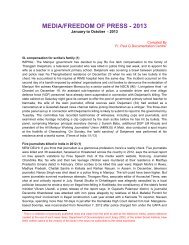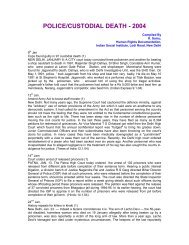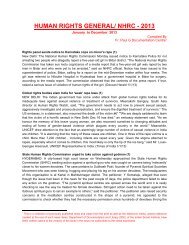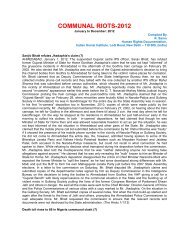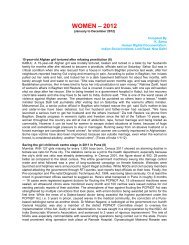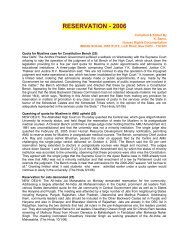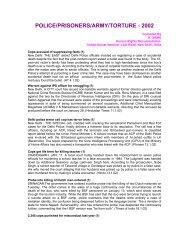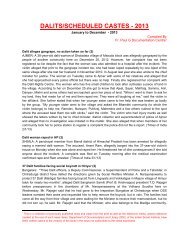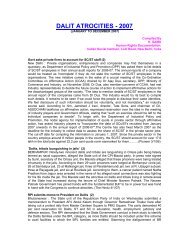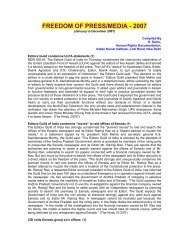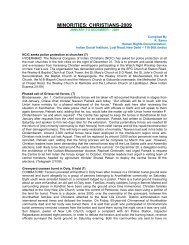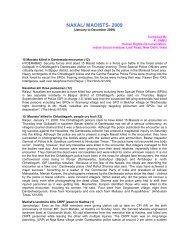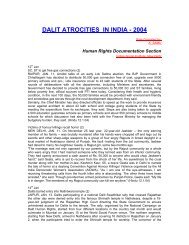TRIBALS â 2007 - Indian Social Institute
TRIBALS â 2007 - Indian Social Institute
TRIBALS â 2007 - Indian Social Institute
Create successful ePaper yourself
Turn your PDF publications into a flip-book with our unique Google optimized e-Paper software.
The making of India’s first potential tribal university (6)BHUBANESWAR: Five thousand tribal children, a sprawling campus, free food, housing andeducation —formal and vocational — and a hi-tech deemed University next door. This is India’sfirst tribal University in the making, the Kalinga <strong>Institute</strong> of <strong>Social</strong> Sciences (KISS) to be precise, avision realised in Bhubaneswar, a dream nurtured by philanthropist Achyutananda Samanta.Plucked out of the neglected, inaccessible and remote tribal backyard of Orissa, the boys andgirls are part of a project launched with only 100 children on April 1, 1993. A sister concern of theKalinga <strong>Institute</strong> of Industrial Technology (KIIT), KISS is a working dream that trained the tribalchildren to be self-reliant, resourceful and empowered to tackle the challenges of life. For thevisiting media team from Bangalore, KISS was an education in looking beyond urban-centricdevelopment. From the well-stocked library, hostel and computer centre to a medical facility thatinsured every child, KISS is also a home away from home. The institute ensures that the childrenhave enough exposure to their tribal culture, heritage and tradition. Music, meditation andmentoring merged with sports, picnics and festivals to round off an invigorating mix of learningand fun. For the once deprived tribal children, the road from KG to PG is meticulously laid. TheKISS curriculum takes them up from primary to higher secondary, Plus Two to Bachelor ofBusiness Administration and beyond, to post-graduation. If ITI diploma courses are for averagestudents, high school pass outs can opt for driving, TV repairing, mobile phone repair or tailoringVaried careers. The KISS Polyvalent Vocational Training Centre ensures they could even findtheir place in food preservation or canning. From poultry, sheep and goat rearing to pisciculture,dairy farm and agriculture, livelihood projects await them too. For Dr. Samanta, the man behind itall, their happy faces are proof of a dream realised. “After 60 years of Independence, the tribalpeople were still living in forests. It was my dream to change that in a small way. Today, there arechildren here from most of the 52 tribes of Orissa, including 13 primitive tribes. This year, weadded 700 more tribal children to reach the strength of 5,000,” he informed. Dr. Samanta’s faith intheir abilities was fully reinforced when every KISS student who took the State Board examinationpassed. Ninety per cent cleared the Plus Two examinations, a performance far ahead of the Stateaverage of 59 per cent. “Even the dropout rate is zero. Every summer vacation they go home,and everyone returns.”…….. (The Hindu 8/8/07)“ST workers have lowest average years of schooling” (6)NEW DELHI: Low level of education and poor access to land denies workers access to ``goodjobs” in the organised sector. Those with poorest access to education and land are confinedmostly to casual/manual labour with socio-religious identity adding to their vulnerability, accordingto the National Commission for Enterprises in the Unorganised Sector. The Commission in areport on “Conditions of Work and Promotion of Livelihoods in the Unorganised Sector,” saysamong the workers in the unorganised sector, the Scheduled Tribes have the lowest averageyears of schooling at 2.8 years, followed by Muslims Other Backward Classes (OBCs) at 3.8years, Hindu Scheduled Castes at 4.1 years and Hindu OBCs. The upper caste Hindu workers at8.4 years, fared the best, The ST and SC people are predominantly represented in wage labour,the Muslims are overwhelmingly concentrated in self-employment. The report has also found thatwomen workers, especially those with lower social and educational status, faced inherentdisadvantages and systematic discrimination in the labour market. Women in the unorganisedsector have poor earnings and poor working conditions. About 54 per cent of the regular workersamong women are domestic workers. The other segment of disadvantaged workers dealt with inthe report are migrant, child and bonded labourers. About 8-10 per cent of the total workers areseasonal migrants, who are poor and take recourse to migration as a strategy for survival. Thelimited social networks of these migrants further increase their vulnerability in the labour market.The incidence of child labour has been on the decline in the country. However, a largeperspective of considering all out-of-the-school children brings out the continuing nature of childdeprivation. On the issue of bonded labour, the report says that since the problem is defined bythe definition of bonded labour adopted, there was no credible estimate of the magnitude ofbonded labour yet available. Yet, the Commission views the problem as huge in view of theoverwhelming empirical evidence arising from a number of studies and surveys. Agriculturalworkers who are largely in the unorganised sector are an extremely impoverished and vulnerablegroup. Within this group, agricultural labourers are worse off than farmers as they are



